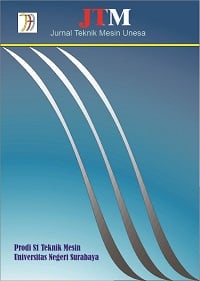PENGUNAAN CORE LANTORSORIC PADA KOMPOSIT TULANGAN BODI MOBIL PROTOTYPE GARNESA
Abstract
Tingginya konsumsi bahan bakar di sektor transportasi mendorong inovasi kendaraan hemat energi melalui pemanfaatan
material komposit yang ringan dan kuat. Penelitian ini mengeksplorasi potensi core Lantor Soric sebagai alternatif
ekonomis pengganti honeycomb pada bodi mobil hemat energi tim Garnesa. Lantor Soric merupakan material berbasis
foam yang ringan, fleksibel, serta memiliki kemampuan meredam getaran dan menyerap energi benturan. Komposit dibuat
menggunakan metode vacuum infusion dengan variasi ketebalan core (2 mm dan 3 mm) serta fraksi volume resin (69%,
71,5%, dan 74%). Uji impak dilakukan untuk mengukur kemampuan komposit sandwich dalam menahan beban kejut dan
dianalisis menggunakan ANOVA satu arah. Hasil menunjukkan bahwa variasi ketebalan dan fraksi volume tidak
berpengaruh signifikan terhadap kekuatan impak, namun core 2 mm secara konsisten memberikan performa yang lebih
baik. Nilai impak tertinggi sebesar 0,3280 J/mm² diperoleh pada core 2 mm dengan fraksi volume 69%, sedangkan nilai
terendah sebesar 0,1864 J/mm² tercatat pada core 3 mm dengan fraksi volume 74%. Kegagalan dominan pada core 2 mm
berupa sobekan, sementara pada core 3 mm berupa delaminasi. Oleh karena itu, kombinasi core 2 mm dengan fraksi
volume 69% direkomendasikan sebagai solusi struktural ringan yang efisien dan terjangkau untuk kendaraan hemat energi.
Kata Kunci: komposit sandwich, Lantor Soric, kekuatan impak, kendaraan hemat energi, vacuum infusion
The high fuel consumption in the transportation sector has driven innovation in energy-efficient vehicles through the use
of lightweight and high-strength composite materials. This study evaluates the potential of Lantor Soric core as a cost
effective alternative to honeycomb for the body structure of the Garnesa energy-efficient vehicle. Lantor Soric is a foam
based material that is lightweight, flexible, and capable of damping vibrations and absorbing impact energy. The
composite was manufactured using the vacuum infusion method with variations in core thickness (2 mm and 3 mm) and
resin volume fractions (69%, 71.5%, and 74%). Impact testing was carried out to measure the ability of the sandwich
composite to withstand sudden loads, and the data were analyzed using one-way ANOVA. The results showed that core
thickness and resin volume variations had no statistically significant effect on impact strength; however, the 2 mm core
consistently provided better performance. The highest impact strength of 0.3280 J/mm² was obtained from the 2 mm core
with 69% resin volume, while the lowest value of 0.1864 J/mm² was recorded for the 3 mm core with 74% resin volume.
The dominant failure in the 2 mm core was tearing, while delamination occurred in the 3 mm core. Therefore, the
combination of a 2 mm core and 69% resin volume is recommended as an efficient and economical structural solution for
energy-efficient vehicles.
Keywords: sandwich composite, Lantor Soric, energy-efficient vehicle, impact strength, vacuum infusion
Downloads
Downloads
Published
Issue
Section
 Abstract views: 46
,
Abstract views: 46
, PDF Downloads: 58
PDF Downloads: 58


